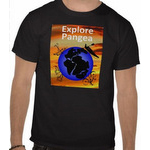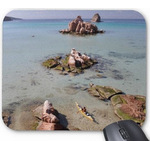• Logbook
• Road Stars
Photo album:
• Villarrica N. P.
Download GPS files for Huerquehue NP:
• GPS track & waypoints
Lodging and eating:
• La cocina de Elisa (Mapuche menus, Curarrehue)
• Lorena Carinao (Lodging and Mapuche menus, Quineñahuín)
In this stage we first visit the Huerquehue National Park in the Araucanía region, where we hike for one day. Then we ride around the park through a rural area with numerous Mapuche communities.
Stage index:
April 24: From Pucón to Huerquehue N. P. (Profile)
April 25: From P. N. Huerquehue to Termas San Luis (Hike profile) (Bike profile)
April 26: From San Luis Hot Springs to Quineñahuín (Profile)
April 27: From Quineñahuín to San Sebastián Hot Springs (Profile)
April 28: From San Sebastián Hot Springs to Lake Colico (Profile)
April 29: From Lake Colico to Melipeuco (Profile)
April 24, 2011: From Pucón to Huerquehue N. P.
After several days in Pucón waiting for the storm to pass, finally today we resume pedaling. The very strong winds during the last days have left branches torn from the trees everywhere. Although the storm is over, today is one of those days when we put on and take off the rain gear too many times.

Our first stop is at the Eyes of the Caburgua, a confluence of two rivers that cascade over a crystalline pool. Later, we reach the Black Beach at the Lake Caburgua and about 1.5 mi from there the White Beach. Both give the impression of receiving many visitors in January and February, but with today´s weather, one cannot imagine spending the summer here.
Then we head to the Huerquehue National Park. The road runs through a very rural area with isolated houses that usually have some sort of business, like the sale of propane tanks or a small groceries store. All have a dog and some of them confuse us with hares. Fortunately, we scare most of them away by a skidding halt and some bad words in Catalan. The trick of picking up a stone is also useful. Upon reaching the entrance, the ranger gives us very good information of the possible hikes as well as the dirt roads around the park to get to the Mapuche communities. He also recommends the Olga Campground for the night, where we go without hesitation.
Yati and Antoin, the couple in charge of the campground, allow us to put up the tent inside the quincho to stay dry. We use the wood stove to dry the bike clothes and warm up the room. They are busy storing everything since it’s the last weekend of the season. Again we're the last tourists of this season.
April 25: From P. N. Huerquehue to San Luis Hot Springs
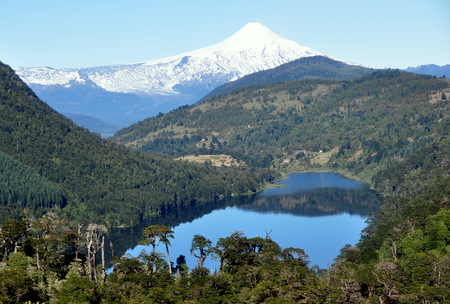
At the beginning of the trail we avoid the mud and puddles, leaping from stone to stone or taking advantage of the trunks and walkways installed for this purpose. But as we gain altitude, the snow gets thicker. When we reach the pass where the lakes are, the snow is over 4 inches deep. Here, the technique is to reuse the footsteps of others who preceded us in previous days, but after a while, our feet are frozen anyway. In this area the forest has a great variety of vegetation and species as diverse as araucaria and bamboo are mixed. Supposedly, in this park we can see pudús, a tiny antelope very elusive. For a moment we think we hear one near us, but we realize it´s an accumulation of snow falling off the bushes. The lakes still have a very dense but shallow fog over the surface. The profile of the araucarias against the blue sky gives the scene a mystical atmosphere. On the way to Lago Verde, we see a couple of woodpeckers pounding on a dead trunk in search of larvae. In the same area we hear the sound of what could be a monito del monte, a marsupial found in this park. We cannot locate it, but the type of sound might make you think it’s a sort of ape, which is impossible in this area. We find a branch of Araucaria on the ground torn by the wind during the storm. According to the ranger they had gusts of 100 mph here. We can see the white and sticky sap bleeding from the core of the branch.
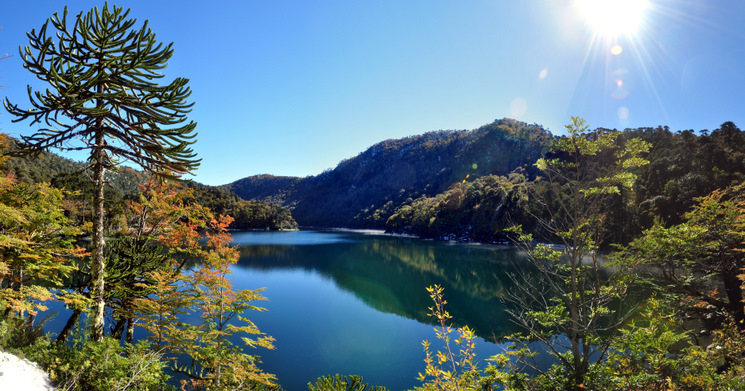
Back at the campsite, we load the bikes, lube the chain and ride down the sneaky hill we climbed yesterday. The secondary roads we ride today pass through grasslands where many caws feed. And you know, where there are cows, there is cow shit. And where there are many cows... It is impossible to avoid them all. The day is gorgeous and we realize that our shadows are back. It's funny how you can be surprised by your shadow following you, but it's been a week without seeing the sun. As the forest has been destroyed for grazing, it is easy to have great views and many times along the way we can see the volcanoes Villarrica and also Lanín, which although far away on the border with Argentina, is clearly visible due to its height. The Villarrica smokes today and we can rest assured it’s relieving pressure from inside.
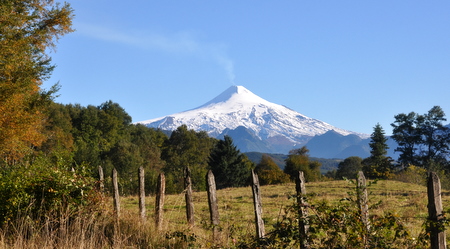
April 26, 2011: From San Luis Hot Springs to Quineñahuín

When we enter Curarrehue we notice some of the Mapuche features: darker skin and somewhat shorter. We ask about the location of the museum to a man who walks around with an ax on his shoulder. The old man, uses the ax as a pencil on the dirt. He draws a sketch on the ground to give us directions. At some moment, with all his vigorous indications we thought he would lose the grip on the handle and inadvertently throw the ax at us.

After Curarrehue, we enter the heart of a Mapuche area, where different communities are scattered throughout the side valleys. To maintain contact among them, wherever the roads cannot reach, hanging bridges have been built in areas where the rivers form canyons. We can see ox carts to transport goods from one place to another.
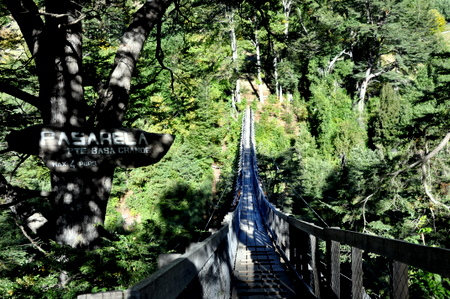
April 27, 2011: From Quineñahuín to San Sebastian Hot Springs
Darío’s dog barks wake us up. It is still dark and cold outside and we go back to sleep. The tent door creaks due to the frost when we open it to go out. We have breakfast in our hosts’ house, say goodbye and start riding toward Reigolil, the last village in the valley.
The terrain is very similar to yesterday's and we keep seeing the locals carrying out their regular chores such as plowing the fields with oxen, travelling by horse or hitchhike sitting in the sun. When we get to today’s pass it starts to rain. The rain is fine, but we know how it goes and the area we are heading to is blurred behind a curtain of water. Under a big tree we put all the rain gear we have. This time even rubber gloves, the ones you use to wash the dishes, over the neoprene ones, to keep our hands dry. The downhill from the pass is really steep, about 1400 feet in less than 6 mi. The rubber gloves are not working. Although we bought the largest size, they are too tight and reduce the blood flow. As a result, the fingers get numb and cold. I also realize that the brake bleeding done in Pucón is not working either. While it is true that the front disc is not dragging anymore, it is also true that the braking power is close to nothing. When we reach the turn off to the Termas San Sebastian, we are starting to get wet. We have only 3 more miles, but the rain intensifies and we get there with our hands and feet soaked. Luckily, we can camp inside the quincho. We hang the wet clothes to let them drip and go to the hot springs to warm up. In this case it is a kind of big bathtub in a private thatched hut. There is nobody else at the hot springs, so it doesn’t matter it’s private. The bathtub has 2 taps. The hot water comes out at 60 degrees. The cold comes directly from the river and it’s probably below 10. We stay there for a while, relaxing while the rain is still pounding the wooden roof.

The rain falls relentlessly. At the door of the quincho there is a pool almost impassable. If tomorrow keeps raining like this is going to be terrible to leave, no matter how dry the clothes are.
April 28, 2011: From San Sebastián Hot Springs to Lake Colico
We cannot believe our eyes: there are no clouds in the sky. The sun is still hidden behind the mountains, but it’s amazing the change from last night. Without wasting any time we set off after a quick breakfast, but the cold makes us stop every few miles at every corner of the road where the sun shines. The track continues to lose elevation through the thick forest and crosses countless streams, rivers and waterfalls.
When we get to the north end of Lake Caburgua, we stop at the campsite owners´ house to buy some cookies. First the grandmother comes out with her hands stained with what looks like blood. She doesn’t know if there are any cookies left and goes back in to look for her daughter ... or for a sharp knife! Then we see the string of featherless chickens hanging from the eaves of the house. The arrival of the daughter doesn’t reassure us at all. She brings some packets of biscuits in her hands but her apron is dotted with red. Meanwhile, a turkey has approached us cheeping like giving us notice of danger. The daughter seems nice and explains they are preparing rosehip jam and that’s the reason for the red stains. We look suspiciously at the chickens, take the cookies and get the heck out of there without thinking. We look for the path that leads to the lake shore in the campground and have lunch. From here we have a breathtaking view of the Villarrica volcano, across the lake. Today is not smoking, so internal pressure is going up.
The road is pretty flat now and the forest has been replaced by pastures, letting the sun warm us up. When we arrive at Lake Colico we realize that we forgot a pair of neoprene gloves where we had lunch, 10 mi behind. We ride back until we reach the first inhabited house. There we ask Sandra, the owner, if there is any kind of transport to take us to find the gloves. She replies that her husband is about to come back and that he can take us. Here the turkeys and chickens seem to be quiet, so we decide to wait. We also decide to stay and camp on her backyard because the sun will be too low to continue pedaling by the time we come back.
With the gloves recovered and the tent set up we go to the house and wait for dinner. From outside the house, while Sandra prepares dinner we hear her saying "Go away asshole". A bit surprised, we cross the kitchen and move into the dining room. From the window we see that the chickens keep feeding around the house quietly. The TV is blaring stupidities from Laura’s mouth, the lawyer in a Mexican reality show. Infidelity is the favorite theme. From the kitchen, occasionally we hear again: "Go away asshole". I'm starting to get nervous, since I’m the only man in the house. Fortunately, Laura just resolved the case and deemed the husband guilty and she says: "Go away asshole". Overwhelmed with joy, Sandra appears from the kitchen with a knife in her hand and repeats: "Go away asshole" but her smile calms us down.
We share dinner with a stranger that right after finishing moves to the couch to watch TV with Sandra and her husband René. The reality show is over. Now we have a terrible soap opera the three of them follow with devotion. We keep busy with the laptop and the iPhone, but we lose concentration when the-bad-guy/girl-appears-on-stage music sounds. When we go to the tent, we still seem to hear "Go away asshole".
April 29, 2011: From Lake Colico to Melipeuco
The day goes by without too many adventures. Before leaving we fix a flat on the front wheel of Judit’s bike. The job has now problem if it wasn’t for the fresh shit stuck to the tire. Passed the test we ride the same stretch we did yesterday and continue around Lake Colico. We are surprised by the waves travelling from east to west. We suspect this change in wind direction has something to do with the beautiful days we are having since yesterday.
Once on the asphalt that will take us to Cunco, we pass a bus stop from where we have an exceptional view of the Llaima volcano, in Conguillio National Park, to which we are headed. In Cunco we reload supplies and refuel of animal protein in the form of steak and veal stew. With our bellies touching the bike frame horizontal bar, we head to Melipeuco, our destination today. The 19 mi go by fast and after finding accommodation we dedicate some time to take care of the bikes. According to locals, forecast announces good weather for the next 4 days. According to the website we usually check, it should not rain in the next 2 weeks!! Too good to be true. Is it the wind coming from Argentina’s pampa pushing the clouds to the Pacific?

